As the families of the men and women who escaped on the
Zeemanshoop
sat down for dinner in the Carlton Beach Club on the evening of Tuesday
13 May the newly restored ninety year old Dutch lifeboat
Zeemanshoop
was entering harbour after successfully completing the voyage from the
shipyard at Zaandam to the North Sea at Ijmuiden and along the coast to
Scheveningen.
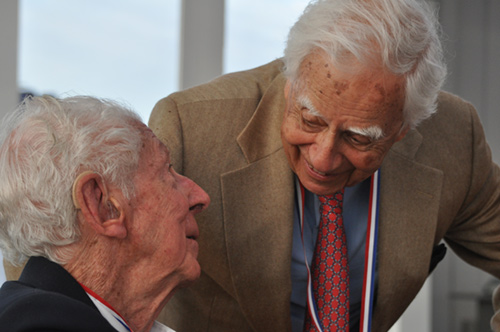
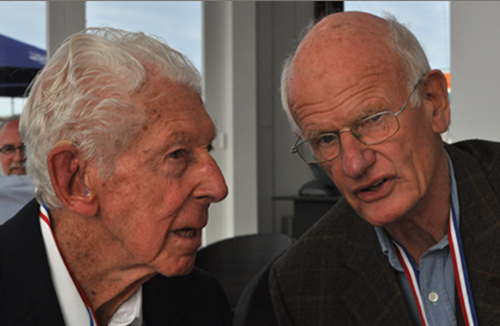
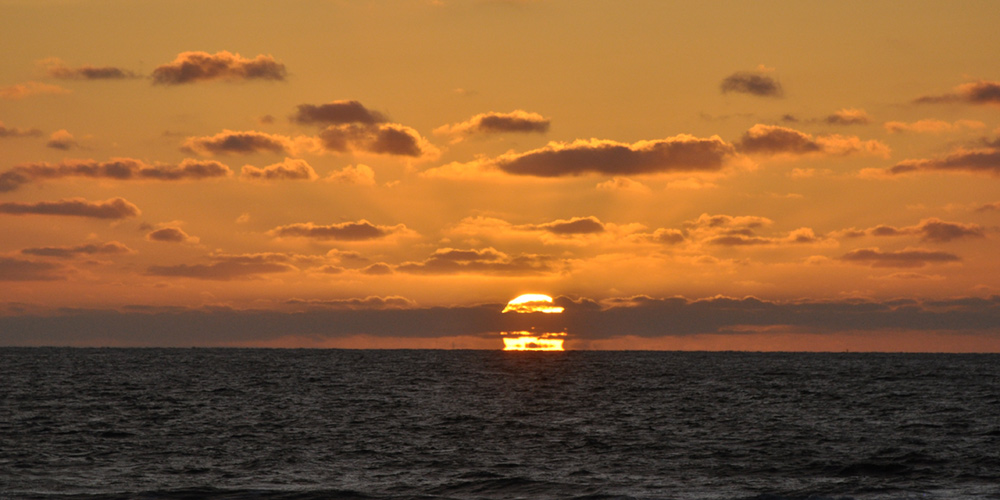 Karel Dahmen and Loet Velmans (left) and Karel Dahmen and Bill Forster (right) at the dinner in Carlton Beach Club on the 13 May
Karel Dahmen and Loet Velmans (left) and Karel Dahmen and Bill Forster (right) at the dinner in Carlton Beach Club on the 13 May
Courtesy of Vic van den Broek d’Obrenan
I sat between Baroness Henig and 95 year old Karel Dahmen and as the
sun set at 22.00 and darkness fell we discussed whether this was the
time when the
Zeemanshoop
powered by a single cylinder of its Kromhout engine set off for
England. Kurt Munzer had told his daughters that it was dark when they left the harbour and Karel Dahmen agreed that
they left at dusk.
The reunion of the families in the Kantine Visafslag
The following morning when the families and guests climbed the external staircase to the Kantine they could see the restored
Zeemanshoop
berthed immediately below and close by the lifeboat from Breskens, the
Zeemanshoop 2, a RIB built with a bequest from
Wim Belinfante, a Jewish lawyer in
the Netherlands Ministry of Justice who escaped on the
Zeemanshoop with his sister.

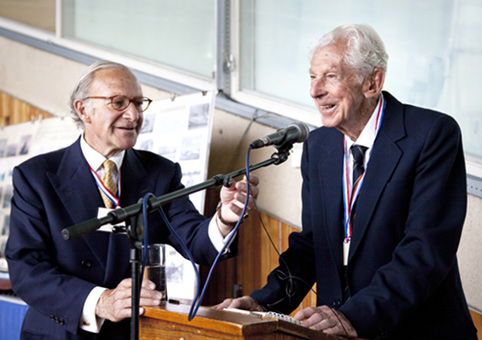 Emile and Robert Louzada in
front of museum display (left) and Robert Louzada adjusts the
microphone for Karel Dahmen (right)
Photographs Amke.nl ©
Emile and Robert Louzada in
front of museum display (left) and Robert Louzada adjusts the
microphone for Karel Dahmen (right)
Photographs Amke.nl ©
Paul de Kievit, Director of the Scheveningen Museum, had
organised a small display which included the chart on which the names
of the 42 passengers and four crew members were recorded with the time
the
Zeemanshoop
left the harbour. On close examination I could see that
Karel Dahmen and Ruth Henig's father were right. The time recorded by a
crew member, probably Lou Meijers, was 9 pm
(22.00 summer time) - plus or minus - and not 19.40 as I had thought
when I looked at a poor quality scan of a printed copy of the chart.
Lis Drew welcomed us and explained how plans were made for the reunion. In his talk
Bill Forster explained why an Englishman who spoke no Dutch was interested in the voyage of the
Zeemanshoop
and the lives of her crew and passengers. He described how he
set about tracing the families and the help he received from people in
the
Netherlands but with almost a third of the names on the "passenger
list" not traced it seemed unlikely that his search would ever end. The
rescue of the men and women on the
Zeemanshoop
was, of course, a minor incident in the context of the fast moving
events of May and June 1940 and he used the photographs taken by Lt
Peter Kershaw RNVR on HMS
Venomous to
tell the story of that dramatic period in the history of this elderly
Royal Navy destroyer as documented elsewhere on this web site. The son
and daughter of Lt Cdr John McBeath RN, the CO of HMS
Venomous in 1940, were in the audience.
Captain John Rodgaard USN (Ret), lead author of the second edition of
A Hard Fought Ship: the Story of HMS Venomous, had come over from his home in Washington, USA.
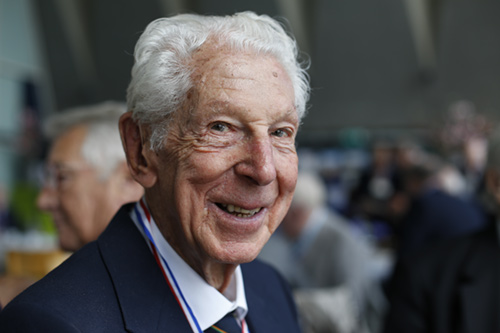
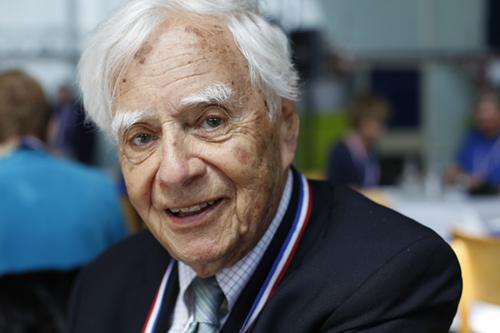 Karel Dahmen on left and Loet Velmans on right
Karel Dahmen on left and Loet Velmans on right
Photographed by Michelle Henning at Scheveningen on the 14 May 2015
Courtesy of Michelle Henning
The two men who were there, 95 year old Karel Dahmen and 92 year old Loet Velmans,
gave their own personal memories of that time.
Karel Dahmen lived
at Roermond near the border with Germany and described how
everything changed after the National Socialists came to power in
Germany and he realised that Europe faced a grim future. He recalled
the many lives lost when
young men attempted to escape by sea to England and the work of the
Genootschap Engelandvaarders (Society of England Travelers).
Loet Velmans
told us of his consternation when having set off on his
great adventure with his cousin they were joined by his formidable
Mother and her
relatives who arrived at the last minute by taxi. On arrival in London
they sought the assistance of an influential family friend, the
Minister of Water Supply in the exiled Dutch government, and were given
a grant to take their son to the Dutch East
Indies to resume his interrupted education with the disastrous
consequences
told in his book,
The long Way Back from the River Kwai (Arcade Publishing, 2003).
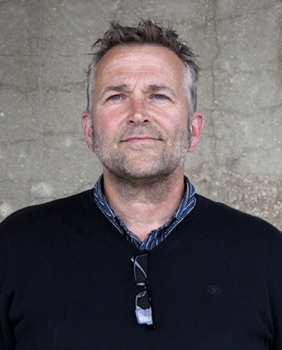
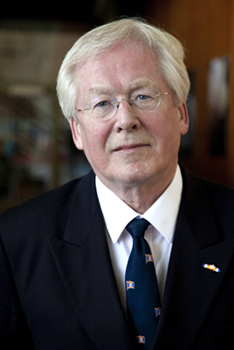 Henk Grootveld
Henk Grootveld (
Left, Amke.nl ©) of the KNRM described the history of the lifeboat station at Scheveningen and the service of the
Zeemanshoop
while stationed there before the war. Then, quite dramatically, the
crew of the present life boat appeared as if by magic standing in a long row
behind him, each wearing identical heavy woolen jumpers bearing the
letters KNRM on their chests.
Jaap Boersma (Right, Amke.nl ©) was still unshaven after yesterday's voyage of the
Zeemanshoop along
the Dutch coast, powered by the seventy year old two cylinder Kromhout engine and
escorted by the
Neeltje Jacoba. His friend, Theo de Boer, was given five years to live in his early forties
and asked Jaap's advice on a
boat to buy. Jaap recommended a decommissioned Dutch lifeboat and Theo
bought the
Zeemanshoop.
He
fitted a six cylinder Volvo Penta diesel engine and high cabin changing
its appearance completely and spent his final years on long voyages,
sometimes alone and sometimes with his young family. He went as far
afield as Gothenburg and when he died in 2009 his ashes were scattered
at sea from the
Zeemanshoop.
The
Zeemanshoop
was on the market for several years before Jaap negotiated its purchase
by the Neeltje Jacoba 1929 Foundation in February 2015. Jaap had
already restored the famous Dutch lifeboat
Neeltje Jacoba and now took on the task of restoring the
Zeemanshoop
and making her the eye-catcher of the lifeboat museum on the Frisian
island of Ameland. The Foundation received large grants from local
government but despite much of the work being done by unpaid
enthusiasts they needed to have a substantial amount of work done at
Kramers shipyard at Zaandam in order to bring the
Zeemanshoop to Scheveningen on the anniversary of her voyage to England.
You can read about the restoring of the Zeemanshoop here.
Visiting the Zeemanshoop in the harbour
An informal buffet lunch was served in the Kantine but most of us made
a quick dash for the external staircase leading to the pontoon where
the
Zeemanshoop was berthed
with the modern RIB lifeboat from Breskens moored on the opposite side.
Karel Dahmen and Loet Velmans were filmed by a television crew as well
as facing a battery of cameras belonging to family members. The slow
drumbeat of the Kromhout engine rolled out again and quickened as Jaap
Boersma took the
Zeemanshoop
to the point where the original protective moles ended and then
returned with Karel Dahmen at the helm just as he was 75 years ago. A
further short excursion was made with the deck almost as crowded as it
was in 1940.

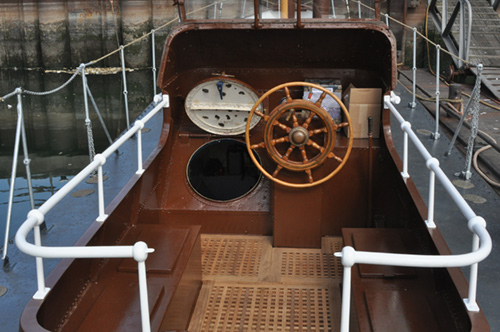
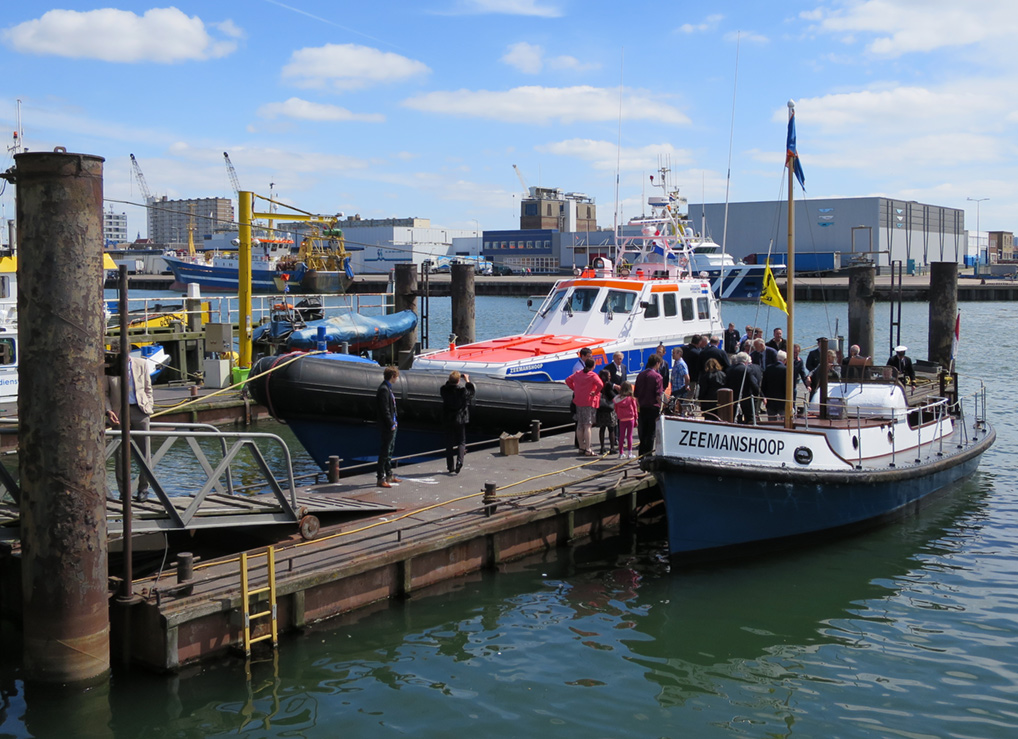 Top: The bow and cabin of the newly restored Zeemanshoop with the hatch into the engine compartment. Courtesy of Vic van den Broek d’Obrenan
Bottom: The Zeemanshoop built in 1925 (right) is dwarfed by the Zeemanshoop 2, the lifeboat at Breskens on the Scheldt estuary opposite Vlissingen (Flushing) Courtesy of Bill Forster
Top: The bow and cabin of the newly restored Zeemanshoop with the hatch into the engine compartment. Courtesy of Vic van den Broek d’Obrenan
Bottom: The Zeemanshoop built in 1925 (right) is dwarfed by the Zeemanshoop 2, the lifeboat at Breskens on the Scheldt estuary opposite Vlissingen (Flushing) Courtesy of Bill Forster
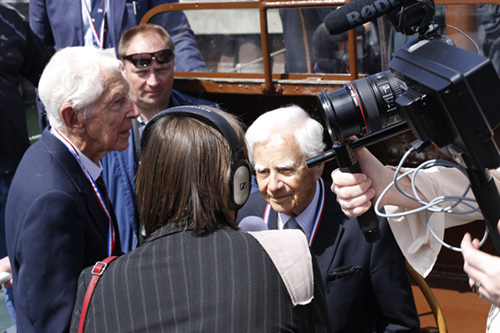
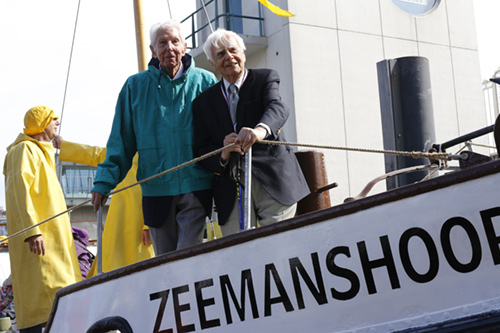
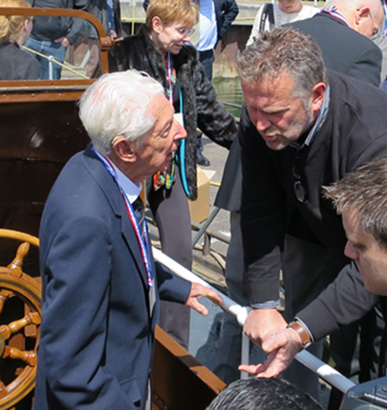
 Karel Dahmen and Loet Velmans are filmed on the Zeemanshoop (top left) and on the bow of the Zeemanshoop (top right)
Karel Dahmen and Loet Velmans are filmed on the Zeemanshoop (top left) and on the bow of the Zeemanshoop (top right)
Karel Dahmen talking to Jaap Boersma the man who restored the Zeemanshoop (bottom left) and at the wheel of the Zeemanshoop
Courtesy of Michelle Henning and (bottom left) Bill Forster
Ruth Henig was photographed with three generations of her family, the
youngest having been let off school on condition they wrote an essay on
the voyage of the
Zeemanshoop
and what it meant to them. "Why I was born in England" occurred to me
as a suitable title. And then Loet Velmans, a seventeen year high school student in 1940 but now a
92 year old great grand-father, was photographed with his family.
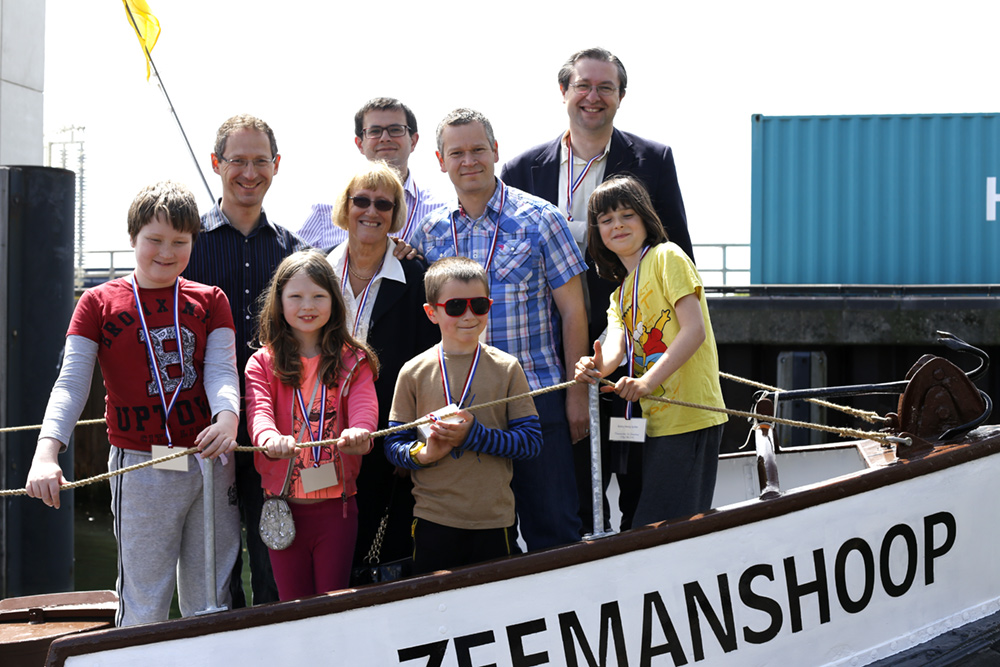 Baroness Henig (centre) with the grandchildren and great-grandchildren of Kurt and Freda Munzer
Baroness Henig (centre) with the grandchildren and great-grandchildren of Kurt and Freda Munzer
Courtesy of Michelle Henning
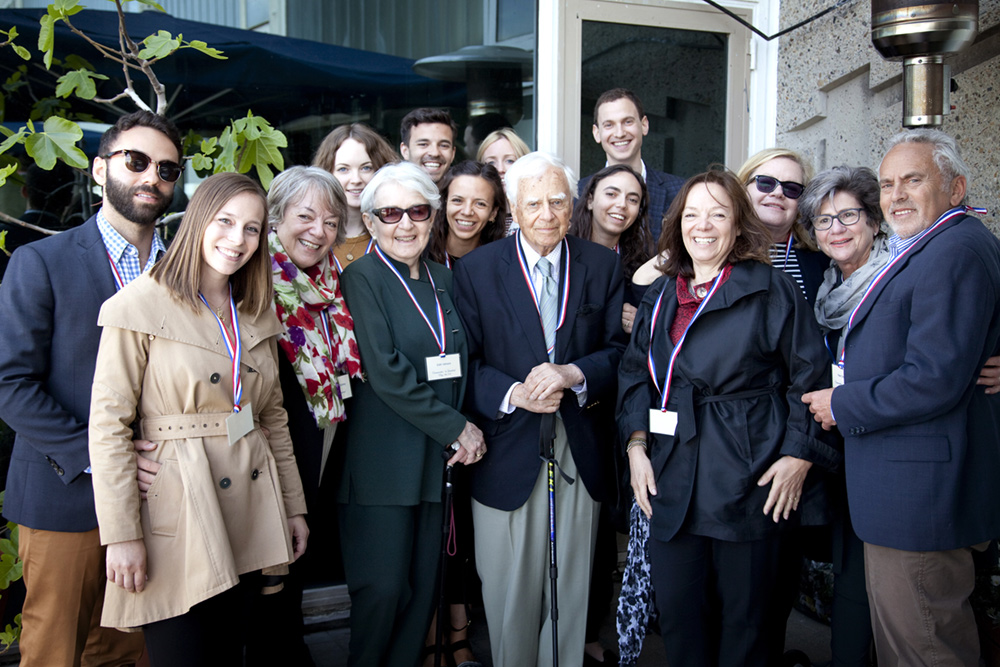 Loet Velmans and his family
Photograph Amke.nl ©
Loet Velmans and his family
Photograph Amke.nl ©
The afternoon session in the Kantine
Baroness Ruth Henig, Member of the House of Lords (Photograph Amke.nl ©)

Baroness Henig spoke about how her parents,
Kurt and Freda Munzer, came to be on Scheveningen
beach on the fateful evening of 14 May. They were German Jews who
had been forced to leave Germany in the mid 1930s, and they met and
then married in Enschede in 1939. By 1940 they were living in The Hague
and her mother was four months` pregnant. When news came of the
Nazi invasion of Holland, she became hysterical and begged that they
try to escape as soon as possible, hence their attempt on 14 May to
find a boat to take them to safety.
On arrival in England, they were separated, imprisoned for three weeks
in London on suspicion of being Nazi spies, and then sent to internment
camps on the Isle of Man. They were not reunited for over a year,
during which time Baroness Henig`s elder sister Evi was born on the
Island. Some time before the birth, her father wrote to Queen
Wilhelmina via the exiled Dutch Government in London, telling her that
he and his wife had been forced to flee from Holland with only the
clothes and possessions they had on them, and, with a baby on the way,
had no baby clothes or blankets available. Within a short time,
parcels of clothes arrived on the Isle of Man, including beautiful baby
outfits and blankets. As a result, Evi was the best dressed baby
on the Island, and Baroness Henig`s parents never forgot the kindness
and generosity of the Dutch Royal family. As a result, when she herself
was born, three years later, she was given the middle name Beatrice,
after the Dutch princess Beatrix.
Radboud Hack

Radboud is the son of Harry Hack who took on the role of "captain" of the
Zeemanshoop.
Harry Hack was studying marine engineering and had been an apprentice
engineer on a voyage to the Dutch East Indies. He was confident that if
he
could find a boat he could get it to England even without
a crew but had not expected the 42 passengers who
clambered aboard while he was working on the engine but coped with
the situation and deserves most of the credit for the success of the
voyage.
Radboud trained as a marine architect and is well qualified to discuss
the controversy over whether "to go on or to go back". The sea was
calm but if it changed any sudden movement on
the part of the passengers to one side or other of the lifeboat would
have led to a capsize with the tragic consequences we have seen
recently with the "Boat People" in the Mediterranean.
He set the crew and
passengers tasks to keep them occupied and prevent them worrying during
the long night at sea and when HMS
Venomous
was sighted the following afternoon he brought her safely alongside so that his passengers could clamber up the
scrambling nets.
The story would have had a different ending had they not been sighted by HMS
Venomous
or if she had ignored their distress signals. If they had spent a second
night at sea the likelihood is that even if the weather had remained
calm the passengers would have become agitated and any attempt on their
part to change position or enter the small cabin would have led to a
capsise and the death of all onboard.
Radboud ended his talk by
thanking the Royal Navy for their rescue.
You can read Radboud's detailed resume of his talk in English and Dutch.

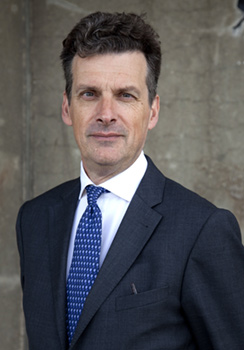 Jozias van Aartsen, Mayor of The Hague (Photograph left Amke.nl ©)
Jozias van Aartsen, Mayor of The Hague (Photograph left Amke.nl ©)
The Mayor began his talk with these words: "Never before was the term
‘lifeboat’ more appropriate. And never before the phrase ‘hijacked’
less so." He mentioned the similarities between Loet Velman's story and
that of the Dutch poet Leo Vroman who also escaped from Sheveningen in
May 1940 only to become a POW of the Japanese in the Dutch East Indies
and died last year in Fort Worth, USA, aged 98. Many of these
passengers on the
Zeemanshoop
came from The Hague, "where the international community holds to
account those who violate international law and human rights". He ended
by hoping "that 'De Zeemanshoop’ will continue to serve as a reminder
for us – and the city of The Hague – that we should never stop working
towards peace, safety and justice in our world. Both today and in the
future."
You can read his full speech here.
Sir Geoffrey Adams, British Ambassador to The Netherlands (Photograph right Amke.nl ©)
The British Ambassador talked about the enduring values of the
human spirit, manifested in the resourcefulness and courage shown by
the students and their "passengers" in seizing the opportunity to
escape and dealing with the problems faced during the voyage, and how
these qualities are needed today to cope with the problems of the
modern world.
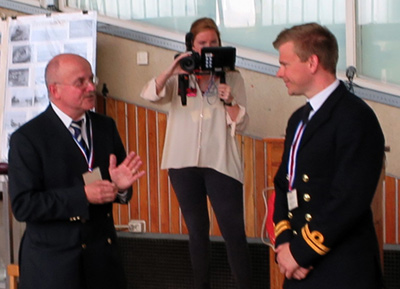
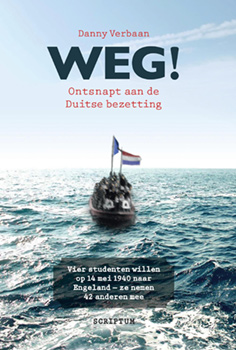
 Lt Chris Chew RN, CO of HMS Trumpeter RN with Radboud Hack, the son of "Captain" Harry Hack of the Zeemanshoop being filmed by Laurelle Bakker for a video of the anniversary (left)
Lt Chris Chew RN, CO of HMS Trumpeter RN with Radboud Hack, the son of "Captain" Harry Hack of the Zeemanshoop being filmed by Laurelle Bakker for a video of the anniversary (left)
Danny Verbaan talking about his book Weg! on the voyage of the Zeemanshoop (right)
Photographed by of Bill Forster
, Dutch journalist and author, talked about
Weg! his book on the voyage of the
Zeemanshoop
which was completed just in time to be launched at the reunion on the
anniversary of the voyage. The Scheveningen branch of the KNRM told the
German occupiers that the
Zeemanshoop
had been seized by soldiers, either a deliberate misrepresentation of
the facts to avoid trouble or, perhaps, based on a rifle being fired by
the sergeant in the Meerchaussen to discourage further people climbing
aboard. He expressed regret that Tinus Rog, the young fisherman
who helped start the Kromhout engine was not there today to see the
book launch. Tinus Rog lived in Scheveningen but had died in February.
He thanked Bill Forster for helping him with research and copies of his
book were presented to Karel Dahmen, Loet Velmans and Bill. His
publisher was there to sell the book and Danny was kept busy signing
copies.
The formal proceedings ended with
the presentation of plaques recording the voyage of the
Zeemanshoop
seventy five years ago. A large plaque which will be placed on the new KNRM
boathouse in Scheveningen when opened in 2017. Reduced size plaques were presented to Jaap Boersma for the restored
Zeemanshoop,
and to Karel Dahmen and Loet Velmans. Finally, a small plaque with the
inscription in English was presented to Lt Chris Chew RN, the CO
of HMS
Trumpeter, for display aboard the training ship of the Cambridge University Royal Navy Unit, a fitting end to the day since the
Zeemanshoop was crewed by Dutch students and
Trumpeter
brought two students from Cambridge University to Scheveningen for the
reunion of the families of the 46 men and women whose lives were saved
when they were taken aboard HMS
Venomous on the 15 May 1940.
May 14th 1940 – May 14th 2015
In commemoration of the escape from Scheveningen
of those on board the lifeboat "Zeemanshoop" on May 14th 1940
During their dangerous passage the 46 refugees were taken on board HMS Venomous
and carried to safety in England, thus escaping the occupation of The Netherlands
Presented to HMS Trumpeter in gratitude to the Royal Navy
by and in the name of the voyagers, their families and friends
HMS Trumpeter
HMS
Trumpeter berthed in the inner harbour to make it easier for older visitors to come aboard
. They
were greeted by her CO, Lt Chris Chew RN, and shown round the ship by
Sub Lieutenant Louis Jones RN and the two students from Cambridge University and a student from London
University.
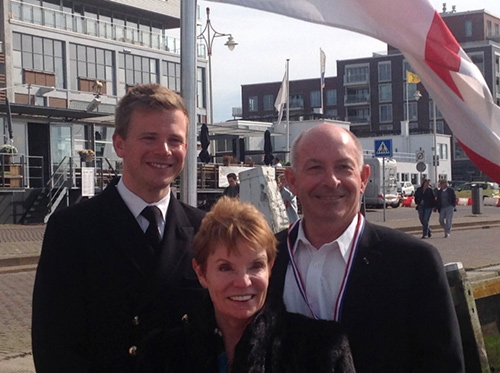
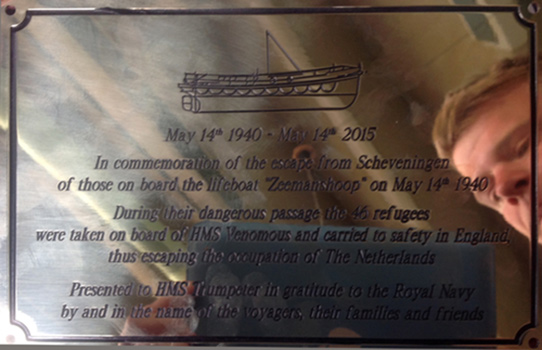
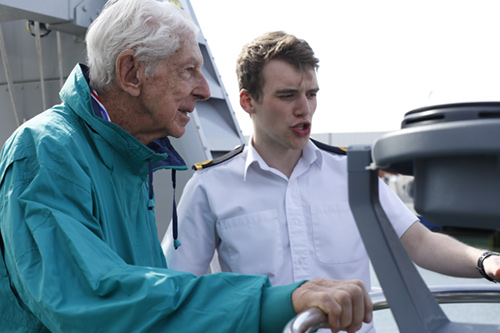
 Top: Lt Chris Chew RN with Capt John Rodgaard USN (Ret), author of A Hard Fought Ship and his wife, Dr Judy Pearson (left) Courtesy of Rosemary McBeath
Top: Lt Chris Chew RN with Capt John Rodgaard USN (Ret), author of A Hard Fought Ship and his wife, Dr Judy Pearson (left) Courtesy of Rosemary McBeath
Lower: Karel Dahmen served in the Royal Netherlands Navy during the war and was given a guided tour of HMS Trumpeter by Sub Lieutenant Louis Jones RN Courtesy of Michelle Henning
It was a wonderful day but there was one disappointment. The CO of HMS
Venomous
in May 1940 was
Lt Cdr John McBeath RN who joined the Royal Navy as a
boy sailor and became the Honorary Commodore of the Sea Cadets after
his retirement
as Rear Admiral and the author of the first edition of
A Hard Fought Ship, the book I published on HMS
Venomous was Bob Moore, the CO of TS
Venomous at Loughborough. Lt Chris Chew RN, the CO of HMS
Trumpeter, invited five Sea Cadets and a member of staff of TS
Venomous in Loughborough to join
Trumpeter
for the short voyage from Harwich to Scheveningen because of this link
between the destroyer which rescued the passengers and crew of the
Zeemanshoop
and the Sea Cadets. Sadly, the Head
Office of the Sea Cadet Corp would not give consent, a disappointment
for the cadets and for the son and daughter of John McBeath who
attended the reunion.







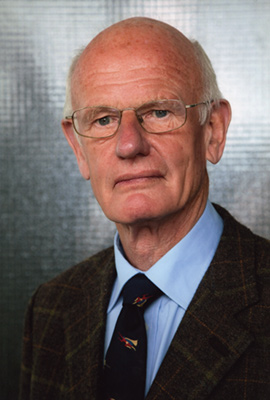 On
the 14 May 2015 one hundred men and women from three continents
met at Scheveningen to commemorate the 75th anniversary of the voyage
of the Dutch lifeboat Zeemanshoop
on the night the Netherlands surrendered to German forces. They were
the families of the four students and 42 passengers who left behind
everything
to save themselves from death in a Nazi concentration camp or to
continue the fight against the occupier of their country from the
island sanctuary of England. Many would not have been born had the
voyage of the Zeemanshoop ended in disaster.
On
the 14 May 2015 one hundred men and women from three continents
met at Scheveningen to commemorate the 75th anniversary of the voyage
of the Dutch lifeboat Zeemanshoop
on the night the Netherlands surrendered to German forces. They were
the families of the four students and 42 passengers who left behind
everything
to save themselves from death in a Nazi concentration camp or to
continue the fight against the occupier of their country from the
island sanctuary of England. Many would not have been born had the
voyage of the Zeemanshoop ended in disaster.  Lis
Drew, the granddaughter of Jozef Jacob (Joop) van der Laan, first suggested organising a reunion on the 75th anniversary of
their escape when we met in London in 2012. In May 2014 I met Lucas
Ligtenberg and Wybe van der Wal at Scheveningen to enlist their help.
Lis Drew in Australia and Radboud Hack, son of the "captain" of the
student crew, joined the planning committee. The Royal Navy offered its support by agreeing to send HMS Trumpeter,
the training vessel of the Cambridge University Royal Navy Unit to the
event with university students from Cambridge and five sea cadets from
TS Venomous at Loughborough. The ninety year old Zeemanshoop was bought by the Neeltje Jacoba 1929 Foundation and Jaap Boersma undertook to restore it to its appearance in 1940 and bring it to Scheveningen.
A Dutch journalist, Danny Verbaan, began writing a book about the voyage
for publication on the anniversary and asked for my assistance.
Lis
Drew, the granddaughter of Jozef Jacob (Joop) van der Laan, first suggested organising a reunion on the 75th anniversary of
their escape when we met in London in 2012. In May 2014 I met Lucas
Ligtenberg and Wybe van der Wal at Scheveningen to enlist their help.
Lis Drew in Australia and Radboud Hack, son of the "captain" of the
student crew, joined the planning committee. The Royal Navy offered its support by agreeing to send HMS Trumpeter,
the training vessel of the Cambridge University Royal Navy Unit to the
event with university students from Cambridge and five sea cadets from
TS Venomous at Loughborough. The ninety year old Zeemanshoop was bought by the Neeltje Jacoba 1929 Foundation and Jaap Boersma undertook to restore it to its appearance in 1940 and bring it to Scheveningen.
A Dutch journalist, Danny Verbaan, began writing a book about the voyage
for publication on the anniversary and asked for my assistance.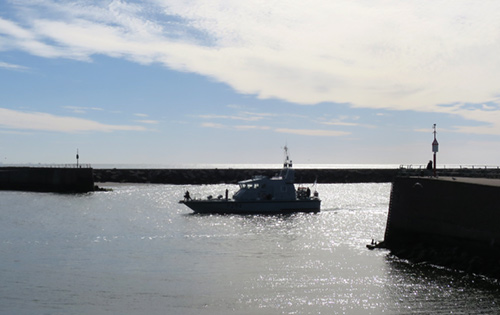
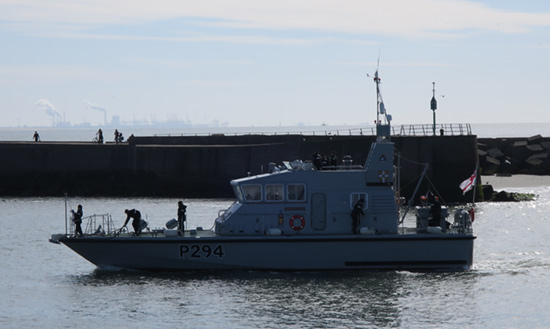
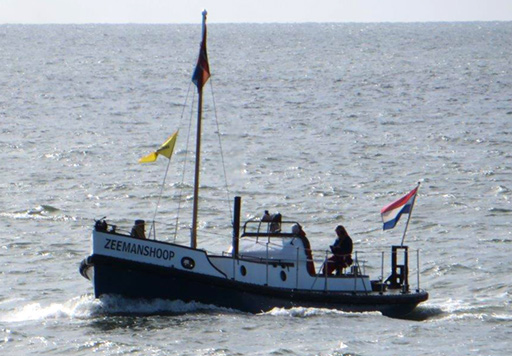
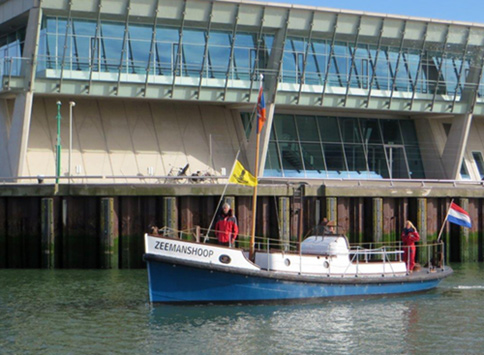








 Henk Grootveld (Left, Amke.nl ©) of the KNRM described the history of the lifeboat station at Scheveningen and the service of the Zeemanshoop
while stationed there before the war. Then, quite dramatically, the
crew of the present life boat appeared as if by magic standing in a long row
behind him, each wearing identical heavy woolen jumpers bearing the
letters KNRM on their chests.
Henk Grootveld (Left, Amke.nl ©) of the KNRM described the history of the lifeboat station at Scheveningen and the service of the Zeemanshoop
while stationed there before the war. Then, quite dramatically, the
crew of the present life boat appeared as if by magic standing in a long row
behind him, each wearing identical heavy woolen jumpers bearing the
letters KNRM on their chests. 









 Radboud is the son of Harry Hack who took on the role of "captain" of the Zeemanshoop.
Harry Hack was studying marine engineering and had been an apprentice
engineer on a voyage to the Dutch East Indies. He was confident that if
he
could find a boat he could get it to England even without
a crew but had not expected the 42 passengers who
clambered aboard while he was working on the engine but coped with
the situation and deserves most of the credit for the success of the
voyage.
Radboud is the son of Harry Hack who took on the role of "captain" of the Zeemanshoop.
Harry Hack was studying marine engineering and had been an apprentice
engineer on a voyage to the Dutch East Indies. He was confident that if
he
could find a boat he could get it to England even without
a crew but had not expected the 42 passengers who
clambered aboard while he was working on the engine but coped with
the situation and deserves most of the credit for the success of the
voyage.
 Jozias van Aartsen, Mayor of The Hague (Photograph left Amke.nl ©)
Jozias van Aartsen, Mayor of The Hague (Photograph left Amke.nl ©)






